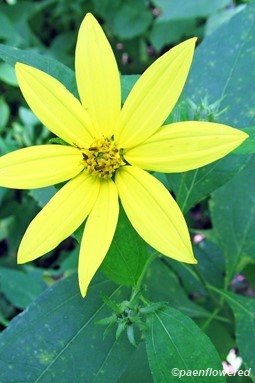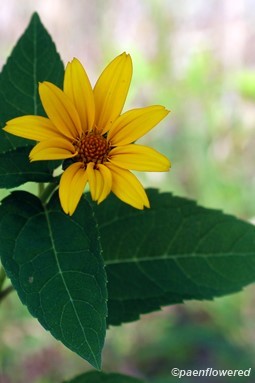Helianthus decapetalus
Helianthus decapetalus thinleaf sunflower
There are a number of plants that resemble sunflowers and you need to know the details of their anatomy to distinguish them. This perennial native sunflower grows abundantly along the edges of moist woodlands, along banks and in thickets beginning in mid-summer. It grows 2-5 feet tall and can be distinguished from other sunflowers because the larger leaves narrow abruptly into long winged petioles. That is the key trait.
The composite flower heads also frequently have 10 petal-like ray florets, the source of their species name, but in practice this number varies between 8 and 12. An alternate common name for this species is ten ray sunflower. The ray florets tend to be long and relatively thin and bright yellow in color. Disk florets are tubular. Flower heads are 2 to 3 ½ inches wide. At the base of the flower head are several green overlapping bracts that bend downwards.
The leaves are thin and have sharp teeth. The upper leaf surface is usually rough. The stem is mostly smooth. Most of the leaves are arranged in pairs along the stem, but upper leaves may be alternate. The leaves spread horizontally from the stem. This species is found throughout much of the eastern half of North America and blooms from August to October. It may form colonies through the growth of the underground rhizome.
The flowers attract a variety of insects that act as pollinators and many other insects feed on the leaves. Younger leaves may be eaten by small mammalian herbivores. The seeds are an important source of food for game birds and songbirds. It is also called the pale sunflower or the forest sunflower.
Habitat & Range
Found in fields, by streambanks and along roadsides.
Present throughout the state.
| EMP: | FACU |
|---|---|
| NCNE: | FACU |
Phenology
Flowers July through September.
Plant Codes
S-rank: No Rank
G-rank: G5 (Secure)








Comments
Have you spotted this plant in your area? We'd love to hear about your experience! Share your comments or questions about the plant below. Comments are moderated before posting.